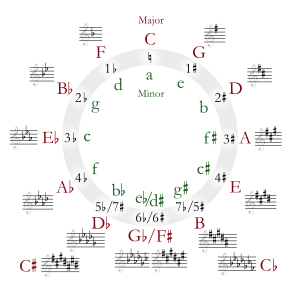G-sharp minor facts for kids
 |
||
| Relative key | B major | |
|---|---|---|
| Parallel key | G♯ major enharmonic: A♭ major |
|
| Notes in this scale | ||
| G♯, A♯, B, C♯, D♯, E, F♯, G♯ | ||
G-sharp minor is a minor scale that starts on the note G♯. A musical scale is a set of notes played in a specific order, going up or down. Minor scales often sound a bit sad or serious compared to major scales.
To play the G-sharp minor scale, you start on G♯. The notes in this scale are G♯, A♯, B, C♯, D♯, E, and F♯.
Contents
Key Signature and Relatives
The key signature for G-sharp minor has five sharps. A key signature tells you which notes are always sharp or flat in a piece of music. This helps musicians know what notes to play without writing a sharp or flat sign next to every note.
Relative Major Key
Every minor key has a relative major key. This means they share the same key signature. The relative major of G-sharp minor is B major. They use the exact same sharps in their key signature.
Harmonic and Melodic Scales
When musicians talk about scales, they often mention different versions. The most common are the natural, harmonic, and melodic minor scales.
- The harmonic minor version of G-sharp minor is special. In this scale, the F♯ note is raised even higher to F
 . A double sharp means you raise the note by two half steps.
. A double sharp means you raise the note by two half steps. - The melodic minor version changes notes when you go up the scale and when you go down. These changes are made using accidentals, which are symbols like sharps or flats that change a note for a short time.
G-sharp Minor in Music
G-sharp minor is not a very common key in music written for a full orchestra. Orchestral music uses many different instruments playing together. Composers usually avoid G-sharp minor because it can be tricky for some instruments to play.
When G-sharp Minor is Used
However, G-sharp minor is more often found in music written for keyboard instruments, like the piano. Famous composers such as Alexander Scriabin used this key in their piano pieces.
Sometimes, if a piece is written in G-sharp minor for piano, and someone wants an orchestra to play it, they might transpose it. Transposing means changing the music to a different key, like G minor or A minor, to make it easier for the orchestra.
Writing Music in G-sharp Minor
When writing music for wind instruments in G-sharp minor, composers need to be careful. For example, if a B-flat wind instrument is playing, its part should be written in B-flat minor, not A-sharp minor. This is because B-flat minor is easier to read and play for those instruments.
In some older music scores, especially for the bass clef, the five-sharp key signature might look a bit different. The sharp sign for the A note might be placed on the top line of the staff.
Scales and Keys
| Diatonic Scales and Keys | |||||||||||||||||||||||||||||||||||||||||||||||||||||||
|---|---|---|---|---|---|---|---|---|---|---|---|---|---|---|---|---|---|---|---|---|---|---|---|---|---|---|---|---|---|---|---|---|---|---|---|---|---|---|---|---|---|---|---|---|---|---|---|---|---|---|---|---|---|---|---|
|
|||||||||||||||||||||||||||||||||||||||||||||||||||||||
| The table shows the number of sharps or flats in each scale. Minor scales are written in lower case. | |||||||||||||||||||||||||||||||||||||||||||||||||||||||
See also
 In Spanish: Sol sostenido menor para niños
In Spanish: Sol sostenido menor para niños


